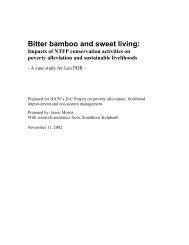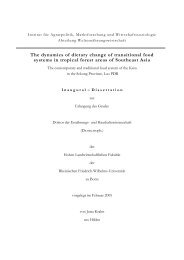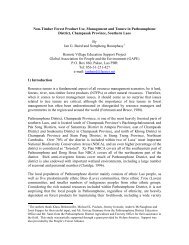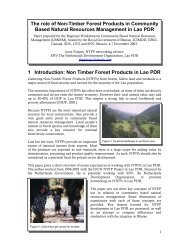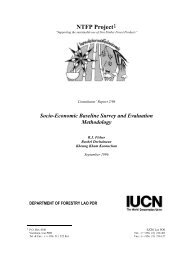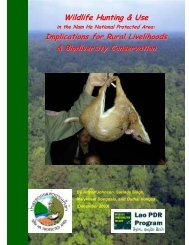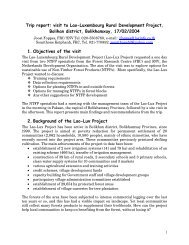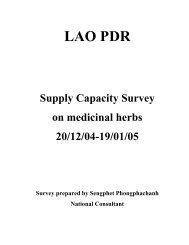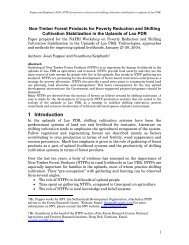Create successful ePaper yourself
Turn your PDF publications into a flip-book with our unique Google optimized e-Paper software.
Rapid Forest Inventory Data<br />
in 3 villages<br />
1 Ban <strong>Nakai</strong> neua<br />
We walked for 30 minutes through dry dipterocarp forest and two hours in evergreen forest al<strong>on</strong>g the<br />
foot mountains to the south west of village with a group men and women. We had lunch in the forest<br />
(huay na kai )and we walked back to village, total six hours . The villagers have showed our team the<br />
important areas for collecting n<strong>on</strong> - timber forest products (NTFP ) as well as the village’s forest<br />
protected area. When we reached the forest our team has observed and made forest block descripti<strong>on</strong>s.<br />
The dry dipterocarp forest (pa kok ) is called “khok sida”. Dominant species are:<br />
Dipterocarpus obtusifolius ‘Mai sad’,<br />
Pinus spp ‘Mai pek’,<br />
Irvingia harmandiana ‘Mai bok’,<br />
Anisoptera chochinchinensis, ‘Mai bak’,<br />
Cratoxyl<strong>on</strong> formosum ,‘Mai tieo som’.<br />
The villagers collect NTFP’s such as : mushroom ‘het’, Curcuma spp ‘Dok ka chieo’and some<br />
wildlife.This area has a sandy soil , crown cover of the forest is 20% and soil cover is 20%,The height<br />
of the main trees is 25 m , and DBH is 30 cm .<br />
The evergreen forest (pa d<strong>on</strong>g dip ) is we visited is callled “ d<strong>on</strong>g houay sod”. This forest is<br />
dominated by main species such as:<br />
Shorea harmandii, ‘mai khen kha yom’,<br />
Dipterocarpus alatus , “Mai nyang”,<br />
Parashorea dussaudii , “Mai si”<br />
Bambusa tulda ,“Maib<strong>on</strong>g”,<br />
Anisoptera cochinchinensis, “Mai bak”,<br />
Hopea ferrea ,“Mai khen”.<br />
The villagers`collect NTFP’s in this area as:<br />
“kisi”, resin of Shorea and Parashorea,<br />
“b<strong>on</strong>g” bark, Notaphoebe umbelliflora,<br />
“san” Raphis sp.,<br />
“boun”, Daem<strong>on</strong>orops schmidtiana,<br />
cardamom “mak neng”, Amomum ovoideum,<br />
“pidin” Globba spp,<br />
“mai sod”, Oxytenanthera pavifolia,<br />
mushrooms, “Het”,<br />
“kheua hem”, Coscinium usitatum,<br />
“chouang hom, Cinnam<strong>on</strong>um litseaefolium,”,<br />
wildlife.<br />
This area has a very good dark soil. Crown cover of the forest is 80% and soil cover is 100%, The<br />
average height of trees is 30m and DBH is 60 cm ,<br />
We estimated the density of ”mai si”, Parashorea dussaudi, to be 100 trees per hectare and bamboo<br />
10,000 clumps per hectare (10,000cl/ha) and 1 clump per 35 culms <strong>on</strong> average. This area is a forest<br />
protected area of nakai village.<br />
2 Ban Sop Phen<br />
We went across the Nam Theun river, then we walked into the dense forest ( D<strong>on</strong>g huay ka ek) to the<br />
east of the village .We walked inside the forest for have d<strong>on</strong>e rapid forest inventories about 4 hours



